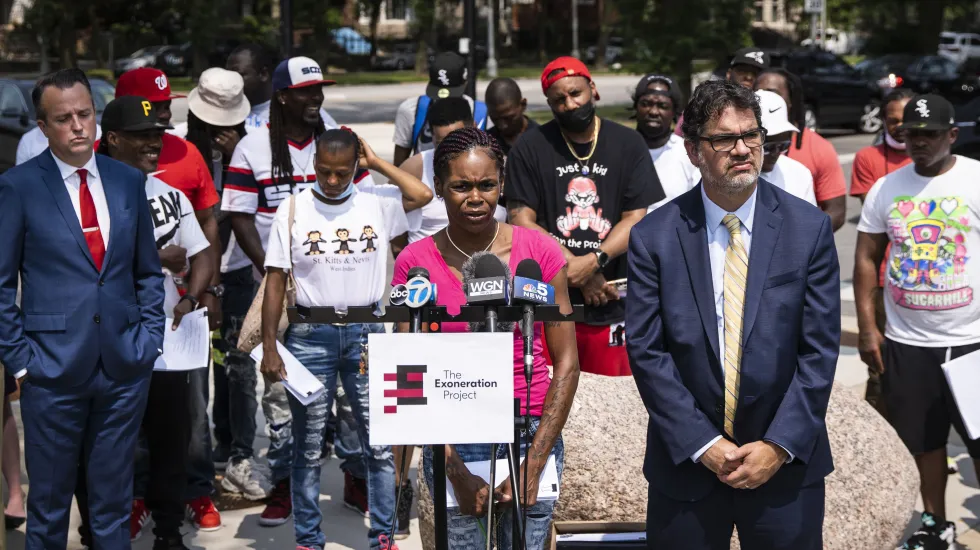
When it comes to police misconduct, the “bad apples” come in bunches, according to a new study of Chicago Police Department data by Northwestern University researchers.
Chicagoans may have learned the name Ronald Watts in recent years, as prosecutors have thrown out more than 200 convictions based on arrests made by the disgraced police sergeant’s unit. And the “Austin 7” made headlines in the mid-1990s, when federal prosecutors charged the septet of West Side cops in a gang conspiracy.
A team of researchers led by Northwestern sociologist Andrew Papachristos took those infamous CPD scandals, and a third group of officers involved in dozens of civil rights complaints, to create a profile of potential corrupt “crews” inside the department.
Using an algorithm to comb for patterns among 50 years of arrest reports, citizen complaints, lawsuits and use-of-force reports, Papachristos’ team identified 160 potential crews of officers between 1971 and 2018. The methodology is similar to the “social network analysis” of gang members Papachristos has used to identify likely victims of gun violence.
“This is not surprising to learn that this (police) behavior occurs in groups. That is basic Sociology 101, you learn from the people around you,” Papachristos said in an interview. “Police officers are part of a hierarchical organization, they are in districts together, they go through the academy in cohorts, they work in units and with the same partners … these are not officers acting alone, making a bad decision in the fog of some bad situation.”
All told, crews included less than 4% of the 30,000 officers in the study, but accounted for 14% of all citizen complaints and nearly 30% of all civil rights lawsuits against city — and the payouts in those cases were four times as much as in cases involving officers not in crews. Officers in crews also are more likely to fire their weapons; crew members were involved in 22% of all police shootings in the study period.
About half of the crew members identified were white men, most had more than 10 years with CPD, and, on average, crew members made three times as many arrests as a typical officer. Crews often were linked by their assignment to a given district or unit, but not always.
Papachristos said research ethics prevent him from identifying by name any officers in the potential crews, but said the research would be made available to CPD to develop a system for flagging potential problem patterns.
“If you look at Ronald Watts, there were hundreds of arrests and convictions that have been overturned, and he was only caught because he tried to steal from an FBI informant, and only him and one other officer was ever charged with a crime,” Papachristos said of Watts, indicted in 2011 along with fellow officer Kallatt Mohammed.
“So if we all agree that what Watts did was bad, we have data that can serve as the canary in the coal mine to identify similar patterns of abuse that could indicate criminal behavior.”
Papachristos’ study, being published this week in the journal PLOS One, includes profiles — but no names — of three probable “crews.” He said there were a “not insignificant” number of crews with members active in the department as of 2018, the last year included in the study.
Papachristos also declined to say if the algorithm flagged police involved in other major CPD corruption scandals, like Joe Miedzianowksi, serving a life sentence for leading a drug ring on the West Side in the 1990s, or former CPD commander Jon Burge, whose “midnight crew” of officers are named in dozens of wrongful conviction cases.
The model used to identify the crews was based on three notorious groups of officers: Watts and officers who worked with him in the Wells housing projects in the early 2000s; the “Austin 7” a team of officers (one an active member of the Vice Lords) who were indicted for providing protection to West Side drug dealers; and the “Skull Cap Crew,” a group of five officers who patrolled public housing on the city’s South Side in the early 2000s and have been identified in 138 misconduct allegations over more than a decade.
Watts and the Austin 7 all were sentenced to federal prison for their on-the-job crimes. The Skull Cap Crew members have never faced criminal charges; four of those five officers remained active with CPD as of 2018, according to the study.
The “machine learning” applied to compare some 30,000 officers to the members of the three crews flagged 12 of 17 officers the researchers had identified as part of Watts’s crew, three of the five Skull Cap officers, but none of the Austin 7, Papachristos noted.
“That shows that the model is not perfect, but the data is not either,” Papachristos said, noting the research used only publicly available information. “These officers go to great lengths to conceal their behavior.”
CPD reforms mandated by a federal consent decree include creating an early warning system to identify problem officers. Papachristos said CPD could incorporate a wealth of internal data to improve on his research, and find ways to identify troubling patterns of behavior to break up networks before another corruption scandal.
“Police love data as a way to identify ‘hot spots’ for criminal activity,” Papachristos said. “This is data identifying the hot spots inside the department.”







